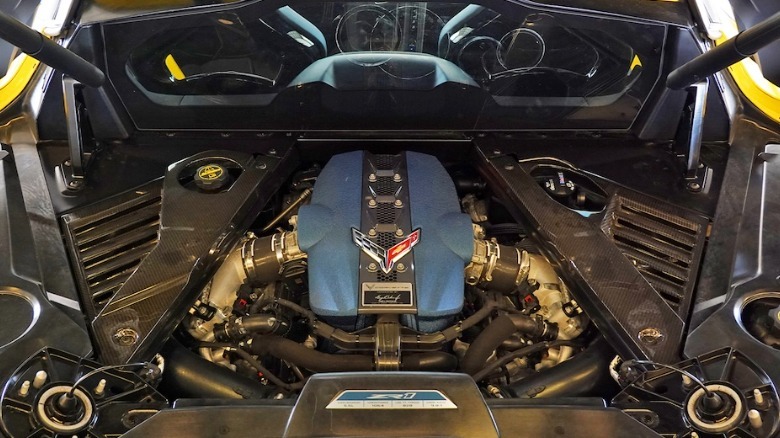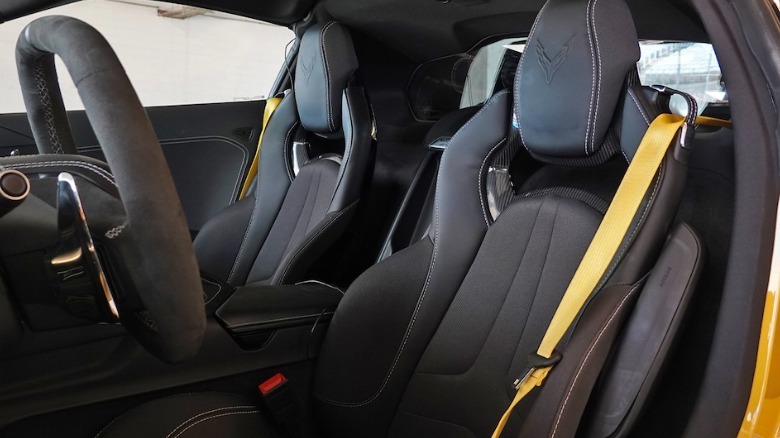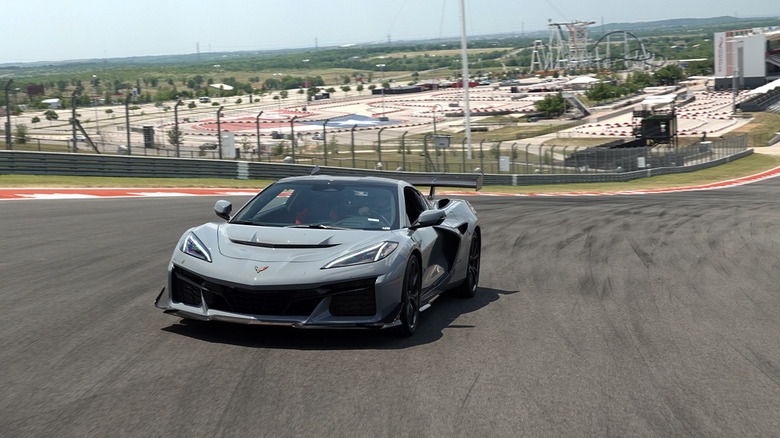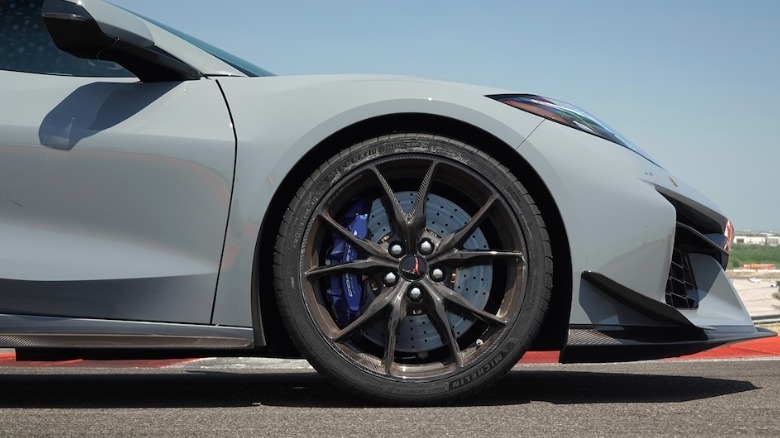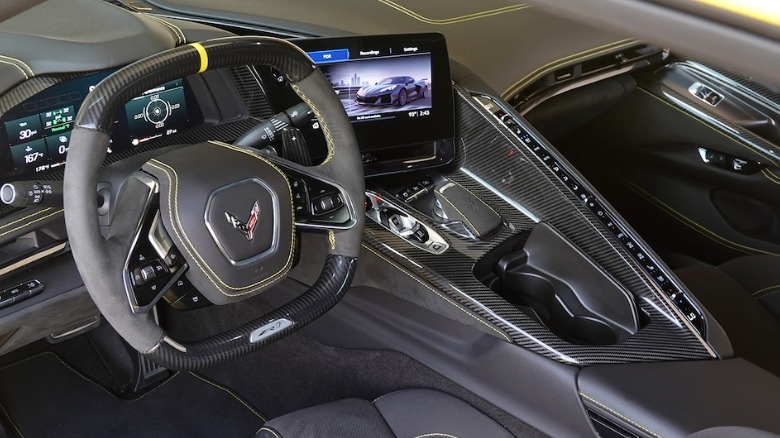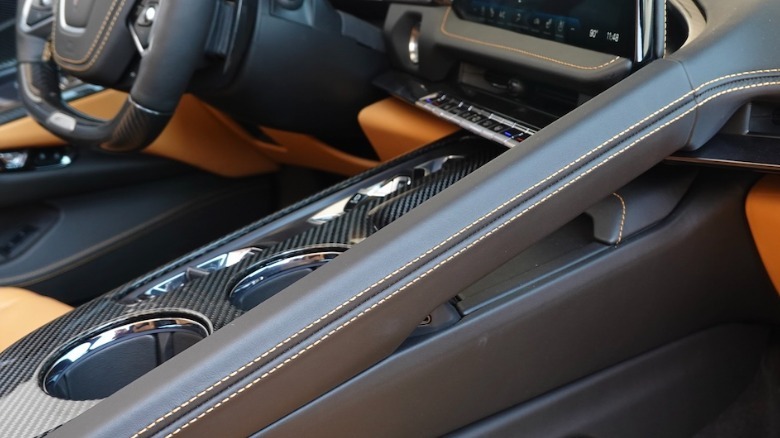2025 Chevrolet Corvette ZR1 First Drive: Is It Too Much For The Road?
The sheer amount of engineering ingenuity that went into the new Chevrolet Corvette ZR1 truly deserves reading up on. Simply put, GM cranked out the most powerful sports car from a major American automaker ever by bolting twin-turbochargers onto a hopped-up variant of the Z06's gobsmacking flat-plane-crank V8.
The resulting 1,064 horsepower helps to explain why Chevy brought select media to Circuit of the Americas in Austin, Texas, for the ZR1's launch program—rather than setting us lucky few loose on public roads, where four-figure horsepower stats and journalistic egos rarely play nice together. In fact, before even handing us the keys to a ZR1, we spent a warmup afternoon the day beforehand doing a series of lead-follow sessions in a "base" Z51 Stingray.
An afternoon at COTA in the base Stingray
Time in the Stingray aimed to allow for an adjustment to COTA as much as anything else, which I appreciated for my first outing on what I discovered to be a surprisingly technical track. That uphill after the stop-start line rises mind-blowingly high, before a hairpin left that transitions back down and around through a series of widening chicanes with a strange topography that tricks the eyes into scoping out the next corner's exit repeatedly.
On public roads, the C8 Stingray's mid-engine layout transformed the Corvette into a borderline supercar for Boxster money. But the 495-horsepower V8 still let me crack well above 140 miles an hour on COTA's long back straight, even if the majority of the lapping time revealed more about braking points and body roll—and absolutely melting a set of Michelin Pilot Sport 4 S tires. The Stingray's soft suspension and steering never approach racecar status, by any means, and do I detect fake engine noises almost drowning out tires squealing?
Nerves starting to bubble up about double the horsepower
By the end of the day, I felt semi comfortable about COTA's layout, but then again, my mind balked at playing chicken with double the horsepower the next morning. The progression continued, however, as we started out in an almost base ZR1—which means internal code FE8—enhanced only with the ZTK aero package. FE8 also sports PS4S rubber on alloy wheels, and the ZR1's most relaxed suspension and steering setup that Chevrolet purposefully dialed down from the more hardcore Z06.
The ZTK aero bits, other than the huge wing, help to bump up downforce in contrast to the fully base car's low-drag frunk Gurney flap and small rear spoiler, which of course still contributed to a 233 mph top speed during testing in Germany.
One hilarious detail I noted while climbing into the ZR1 for the first time: with a full tank of gas, the onboard computer estimated 58 miles of range remaining. Clearly, my compatriots the morning before pushed hard. So I fiddled with the seats, adjusted the ratcheting seatbelts to prevent my torso from snapping forward too much under hard braking, and pushed the stop-start button.
Adjusting to the ZR1's insane power
Immediately, a far more aggressive exhaust note than the Stingray's filled the cockpit, which I just barely fit inside at six-foot-one with the helmet on. I revved a bit, letting the engine warm up, and then pulled out for another tame lead-follow stint. Even after just the first few degrees of steering angle leaving the pits, and then climbing up the hill toward Turn 1, everything about the ZR1 ramped up the feedback and responsiveness to a whole new level.
And then we got into just a hint of boost while blending out onto the track, and I immediately whipped into some oversteer on the cold tires. Alright, here we go. Chasing the pro ahead, as tight as possible with a slight margin for error, that one-third throttle moment of sliding put me in my rightful place. Through the slow sections, I focused on braking hard and accelerating in straight lines to get some heat into the rubber. But by just the second lap, already we crested 170 miles an hour on the back straight before braking a little ahead of the 250-meter sign.
Hard laps, but ready for more
Not messing around, by any means, I spent the next 15-minute solo session trying to find the right line, the right braking points, and the appropriate cornering speeds. I can always wring out a bit more pace while chasing, just by mimicking anyone ahead of me, but on a new-ish track and in a new-ish car, the newfound speeds required a serious mental adjustment. Again, the PS4S tires started to oil up, as I truly found the edge and explored the C8's excellently squared-up, stable tail end. By the end of the stint, I pulled into the pits ready for more, or mostly the FEJ package's Cup 2 R tires.
Ticking all the options adds stiffer spring rates and retuned dampers, carbon-fiber wheels, and the Cup 2 Rs—but the whole package rounds off with revised settings for the brake-by-wire and steering calibrations, too. Once again, just pulling out of the pits, I felt the huge difference as the steering wheel now came alive to dance in my hand, removing any last traces of electrically assisted dullness and conveying each tiny pebble and rubber pellet on the asphalt.
Hitting the highest speed of my life
This session started with another bit of lead-follow and despite pushing harder, the additional grip prevented me from snapping into oversteer on the first pass through Turn 1. Now chasing a pro and a very skilled media member with legit racing experience, thanks to an aerodynamic tow, I hit 181 miles per hour on the back straight by the third lap. And no problemo, no drama, just calm composure at the highest speed of my motorized life.
After a cooldown lap, critical to keep the engine oil temps low enough that the turbos don't boil over while idling in the pits, I took a quick break. I never saw the oil gauge read much higher than 220 degrees F, even as the Texas day started heating up, but one engineer revealed that tight tolerances between the crankshaft and the connecting rods requires the 5W-50 oil to stay below 120 degrees C (or 248 F).
Engineering genius in the new Corvette ZR1
That kind of obsessive optimization allowed Chevy to squeeze 1,064 horsepower out of just 5.5 liters of displacement, as do a matching pair of enormous 76-millimeter turbochargers equipped with electronic wastegates and a turbo speed sensor to eke ever closer to the physical limit of rotational integrity. Equally as important as the outright grunt, the aerodynamic flow over and through the ZR1's body feeds massive radiators and intercoolers—which required sacrificing a usable frunk, sadly—in addition to the downforce, which peaks at 1,200 pounds at the high-drag car's theoretical 224-mph top speed.
I specifically asked what would be the limiting factor, from an engineering standpoint, of just lapping COTA til the ZR1 failed. Turns out, running out of gas—by a long shot. Pushing hard never seemed to upset the unfazeable ZR1, but after my first longer session I limped back into the pits with the fuel light blinking. I figure around eight or nine full-gas laps of the 3.41-mile circuit might drain the tank dry.
Cup 2 R tires make a huge difference
But each of those laps was pretty spectacular. I spent my time trying to learn more about the Cup 2 R tires, which protest less on the way to the edge, so much so that even with the more communicative chassis and steering, I struggled to find the perfect slip angle. And here, as I got more and more familiar with COTA, I discovered a few limitations of the car: namely, that instead of focusing on trail braking through initial turn-in and then rotating around the apex, I found more speed by getting into a straight line as soon as possible—sort of just point-and-shooting, and then trying to avoid understeer while squatting out of corners onto the straights.
I started steering with my right foot a fair amount, essentially driving the turbos in an effort to load up the gargantuan 345-millimeter rear tires. After moments of rocketship acceleration, I needed to work my quad harder and harder to take advantage of the downforce, which helps the carbon-ceramics scrub speed before the shudder of ABS intrudes. And the ZR1's flow through wider sweepers kept me in total rhythm, the balance and weight transitioning perfectly from right to left and back again, then back again, then back again.
Heat and traction control programs thwarting my ego
Yet I still struggled to get anywhere near 181 miles per hour on the back straight again. Instead, I hovered around 175-177 on most laps. Sure, I needed an aerodynamic windblock earlier, but I should be improving. So I started to wonder where my marginal gains might be evaporating. Eventually, the suspicion grew that some of the understeery moments and failures at trying to initiate rotation under trail braking came due to the traction and stability control modes. I kept switching between cars, so I didn't want to mess with the individual settings of the Z-Mode, but holding the button on the center console only turns off TC, not ESC as I wanted. As a result, I kept experiencing some ignition cutoff at inopportune moments, just from rolling over mild curbing right at apex or when arcing out wide along eternal sweepers.
Of course, for production cars approaching racecar status, OEMs still need to keep some controls in place that prioritize sapping speed through understeer rather than whipping up a frenzied moment of irrecoverable oversteer while speeding up. But if I bought a ZR1 and planned to do some track driving, the ability to quickly and easily override the nannies needs to fit into the user interface.
Which perhaps explains some of the C8's new 2026 model year interior glow-up that solves much of the horrifying aesthetics of the "Great Wall of Corvette" center console design—we now know this holds batteries for the E-Ray and any of the widely anticipated future AWD variants—but also critically shifts drive mode selection to a new screen to the left of the steering wheel, complemented by a small bank of physical switchgear below.
A much needed update coming, but for 2026
I quizzed Brian Stoeckel, Interior Design Manager for Corvette, about the inspiration behind the desperately necessary update. "The 2026 interior for Corvette has got updated technology with three all new displays, and then we also improved the cabin ergonomics," he stated, before chuckling. "I think lowering the wall a little bit and giving the passenger a great place to hold on for dear life is gonna be a really good experience for them."
Strangely, even though a grab handle might seem more apropos for the ZR1, Chevy will sell a limited number of 2025 model-year cars before making the switch for 2026. Still, the ZR1 undoubtedly marks an unbelievable achievement, precisely because General Motors somehow made 1,000-plus horsepower actually approachable. In fact, I might argue the ZR1 almost becomes too approachable—because the engineering needed to take into consideration real-world driving, not just hardcore track performance.
How will the ZR1 adapt to real-world driving
Imagining an FEJ with the ZTK aero package on public roads already gave me a back spasm—not to mention the newly useless physical and digital rearview mirror blocked by the massive wing. But despite the spectacular soundtrack echoing off COTA's extensive grandstands, the ZR1 lacks some of the blattering turbo terror of a McLaren 750S, for example. Of course, about 20% less mass to haul around probably makes up for much of the power gap. But the hybrid all-wheel-drive Lamborghini Revuelto also packs a bit more low-end punch.
Those luxury supercars can easily cost double, triple, and quadruple this Chevy, though, which starts at "just" $175k. And in fairness, I also suspect that COTA will make just about any car short of an F1 racer seem slow. Still, I headed home aching and tired still harboring some doubts about the moral responsibility of selling something so unbelievably powerful for the genpop to blast around on public roads—especially when they have time to figure out how to turn the nannies down more easily than I.
2025 Corvette ZR1 Verdict
Even without going wholly off, which might have unlocked a bit more pace, by the end of the day I finally hit 180 miles an hour solo. And that was in the early afternoon heat, when engineers estimated the ZR1's engine lost about 5-10% of its power despite a nifty overboost function allowing the turbos to step up from 20 psi to more like 24-25 psi. True insanity, this ability to hit speeds so high in a car that's so much more affordable than a McLaren or Ferrari or Lamborghini.
But we also know it's not just Hellcats and Mustangs causing problems on social media, plenty of McLaren and GT3 RS dummies crash on camera too. Chevy knows this, and took a big risk building something so powerful. And I'm admittedly torn, between whether to criticize or celebrate the sheer chutzpah of going right ahead and doing so anyway.

